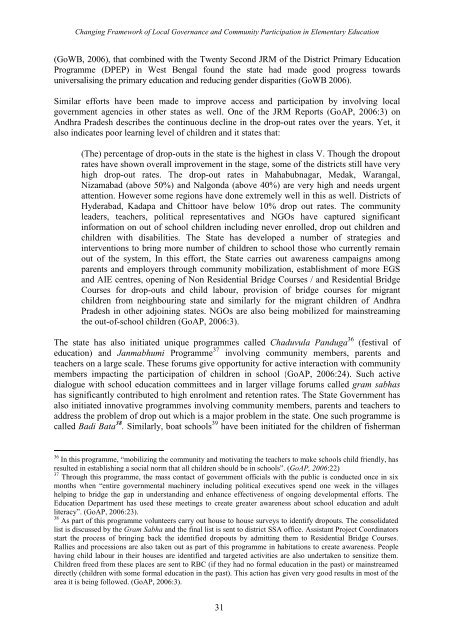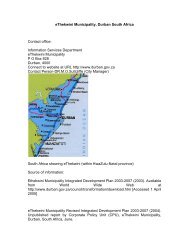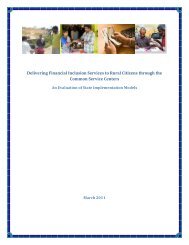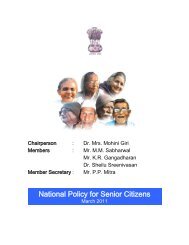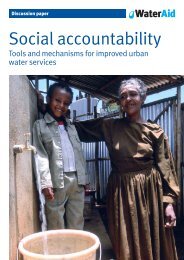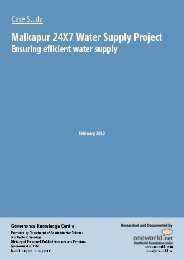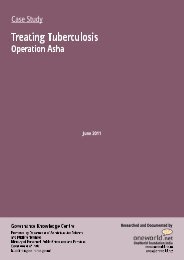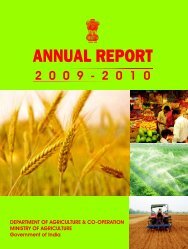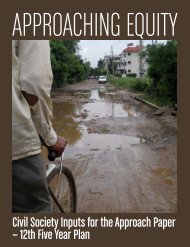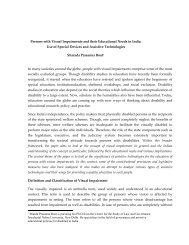Changing Framework of Local Governance and - Create
Changing Framework of Local Governance and - Create
Changing Framework of Local Governance and - Create
Create successful ePaper yourself
Turn your PDF publications into a flip-book with our unique Google optimized e-Paper software.
<strong>Changing</strong> <strong>Framework</strong> <strong>of</strong> <strong>Local</strong> <strong>Governance</strong> <strong>and</strong> Community Participation in Elementary Education(GoWB, 2006), that combined with the Twenty Second JRM <strong>of</strong> the District Primary EducationProgramme (DPEP) in West Bengal found the state had made good progress towardsuniversalising the primary education <strong>and</strong> reducing gender disparities (GoWB 2006).Similar efforts have been made to improve access <strong>and</strong> participation by involving localgovernment agencies in other states as well. One <strong>of</strong> the JRM Reports (GoAP, 2006:3) onAndhra Pradesh describes the continuous decline in the drop-out rates over the years. Yet, italso indicates poor learning level <strong>of</strong> children <strong>and</strong> it states that:(The) percentage <strong>of</strong> drop-outs in the state is the highest in class V. Though the dropoutrates have shown overall improvement in the stage, some <strong>of</strong> the districts still have veryhigh drop-out rates. The drop-out rates in Mahabubnagar, Medak, Warangal,Nizamabad (above 50%) <strong>and</strong> Nalgonda (above 40%) are very high <strong>and</strong> needs urgentattention. However some regions have done extremely well in this as well. Districts <strong>of</strong>Hyderabad, Kadapa <strong>and</strong> Chittoor have below 10% drop out rates. The communityleaders, teachers, political representatives <strong>and</strong> NGOs have captured significantinformation on out <strong>of</strong> school children including never enrolled, drop out children <strong>and</strong>children with disabilities. The State has developed a number <strong>of</strong> strategies <strong>and</strong>interventions to bring more number <strong>of</strong> children to school those who currently remainout <strong>of</strong> the system, In this effort, the State carries out awareness campaigns amongparents <strong>and</strong> employers through community mobilization, establishment <strong>of</strong> more EGS<strong>and</strong> AIE centres, opening <strong>of</strong> Non Residential Bridge Courses / <strong>and</strong> Residential BridgeCourses for drop-outs <strong>and</strong> child labour, provision <strong>of</strong> bridge courses for migrantchildren from neighbouring state <strong>and</strong> similarly for the migrant children <strong>of</strong> AndhraPradesh in other adjoining states. NGOs are also being mobilized for mainstreamingthe out-<strong>of</strong>-school children (GoAP, 2006:3).The state has also initiated unique programmes called Chaduvula P<strong>and</strong>uga 36 (festival <strong>of</strong>education) <strong>and</strong> Janmabhumi Programme 37 involving community members, parents <strong>and</strong>teachers on a large scale. These forums give opportunity for active interaction with communitymembers impacting the participation <strong>of</strong> children in school (GoAP, 2006:24). Such activedialogue with school education committees <strong>and</strong> in larger village forums called gram sabhashas significantly contributed to high enrolment <strong>and</strong> retention rates. The State Government hasalso initiated innovative programmes involving community members, parents <strong>and</strong> teachers toaddress the problem <strong>of</strong> drop out which is a major problem in the state. One such programme iscalled Badi Bata 38 . Similarly, boat schools 39 have been initiated for the children <strong>of</strong> fisherman36 In this programme, “mobilizing the community <strong>and</strong> motivating the teachers to make schools child friendly, hasresulted in establishing a social norm that all children should be in schools”. (GoAP, 2006:22)37 Through this programme, the mass contact <strong>of</strong> government <strong>of</strong>ficials with the public is conducted once in sixmonths when “entire governmental machinery including political executives spend one week in the villageshelping to bridge the gap in underst<strong>and</strong>ing <strong>and</strong> enhance effectiveness <strong>of</strong> ongoing developmental efforts. TheEducation Department has used these meetings to create greater awareness about school education <strong>and</strong> adultliteracy”. (GoAP, 2006:23).38 As part <strong>of</strong> this programme volunteers carry out house to house surveys to identify dropouts. The consolidatedlist is discussed by the Gram Sabha <strong>and</strong> the final list is sent to district SSA <strong>of</strong>fice. Assistant Project Coordinatorsstart the process <strong>of</strong> bringing back the identified dropouts by admitting them to Residential Bridge Courses.Rallies <strong>and</strong> processions are also taken out as part <strong>of</strong> this programme in habitations to create awareness. Peoplehaving child labour in their houses are identified <strong>and</strong> targeted activities are also undertaken to sensitize them.Children freed from these places are sent to RBC (if they had no formal education in the past) or mainstreameddirectly (children with some formal education in the past). This action has given very good results in most <strong>of</strong> thearea it is being followed. (GoAP, 2006:3).31


